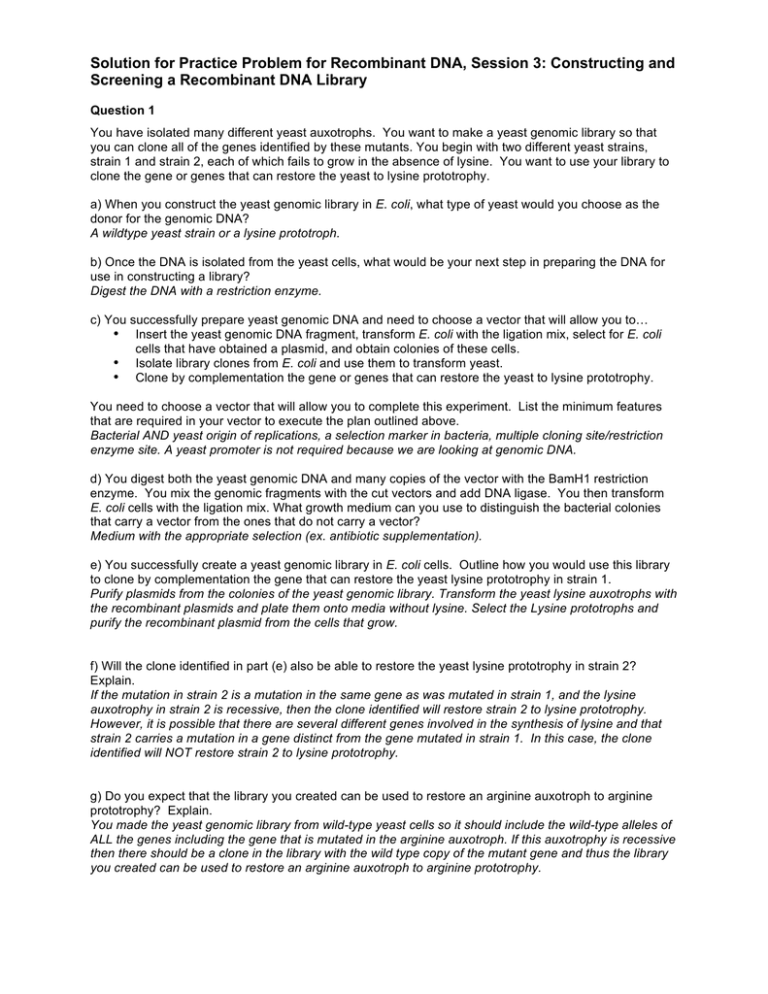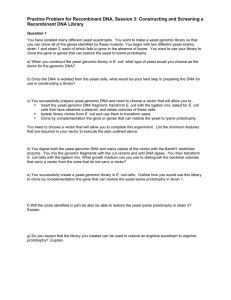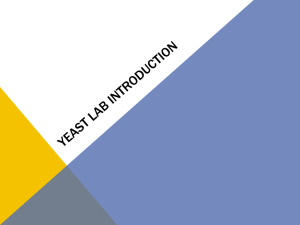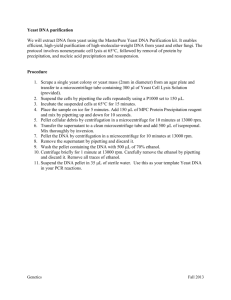Document 13525716
advertisement

Solution for Practice Problem for Recombinant DNA, Session 3: Constructing and Screening a Recombinant DNA Library Question 1 You have isolated many different yeast auxotrophs. You want to make a yeast genomic library so that you can clone all of the genes identified by these mutants. You begin with two different yeast strains, strain 1 and strain 2, each of which fails to grow in the absence of lysine. You want to use your library to clone the gene or genes that can restore the yeast to lysine prototrophy. a) When you construct the yeast genomic library in E. coli, what type of yeast would you choose as the donor for the genomic DNA? A wildtype yeast strain or a lysine prototroph. b) Once the DNA is isolated from the yeast cells, what would be your next step in preparing the DNA for use in constructing a library? Digest the DNA with a restriction enzyme. c) You successfully prepare yeast genomic DNA and need to choose a vector that will allow you to… • Insert the yeast genomic DNA fragment, transform E. coli with the ligation mix, select for E. coli cells that have obtained a plasmid, and obtain colonies of these cells. • Isolate library clones from E. coli and use them to transform yeast. • Clone by complementation the gene or genes that can restore the yeast to lysine prototrophy. You need to choose a vector that will allow you to complete this experiment. List the minimum features that are required in your vector to execute the plan outlined above. Bacterial AND yeast origin of replications, a selection marker in bacteria, multiple cloning site/restriction enzyme site. A yeast promoter is not required because we are looking at genomic DNA. d) You digest both the yeast genomic DNA and many copies of the vector with the BamH1 restriction enzyme. You mix the genomic fragments with the cut vectors and add DNA ligase. You then transform E. coli cells with the ligation mix. What growth medium can you use to distinguish the bacterial colonies that carry a vector from the ones that do not carry a vector? Medium with the appropriate selection (ex. antibiotic supplementation). e) You successfully create a yeast genomic library in E. coli cells. Outline how you would use this library to clone by complementation the gene that can restore the yeast lysine prototrophy in strain 1. Purify plasmids from the colonies of the yeast genomic library. Transform the yeast lysine auxotrophs with the recombinant plasmids and plate them onto media without lysine. Select the Lysine prototrophs and purify the recombinant plasmid from the cells that grow. f) Will the clone identified in part (e) also be able to restore the yeast lysine prototrophy in strain 2? Explain. If the mutation in strain 2 is a mutation in the same gene as was mutated in strain 1, and the lysine auxotrophy in strain 2 is recessive, then the clone identified will restore strain 2 to lysine prototrophy. However, it is possible that there are several different genes involved in the synthesis of lysine and that strain 2 carries a mutation in a gene distinct from the gene mutated in strain 1. In this case, the clone identified will NOT restore strain 2 to lysine prototrophy. g) Do you expect that the library you created can be used to restore an arginine auxotroph to arginine prototrophy? Explain. You made the yeast genomic library from wild-type yeast cells so it should include the wild-type alleles of ALL the genes including the gene that is mutated in the arginine auxotroph. If this auxotrophy is recessive then there should be a clone in the library with the wild type copy of the mutant gene and thus the library you created can be used to restore an arginine auxotroph to arginine prototrophy. MIT OpenCourseWare http://ocw.mit.edu 7.01SC Fundamentals of Biology Fall 2011 For information about citing these materials or our Terms of Use, visit: http://ocw.mit.edu/terms.






